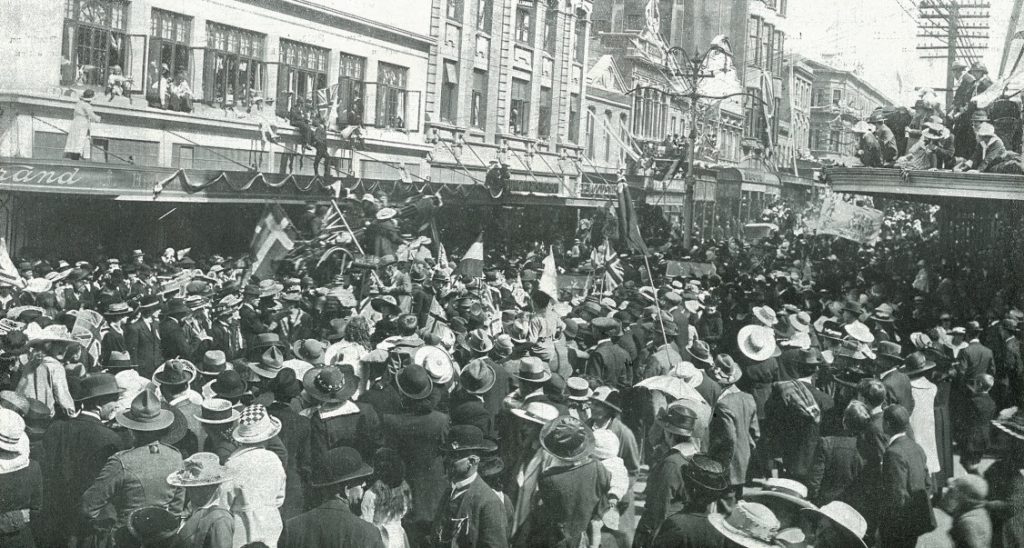Post researched and written by Sarah Hibbs, Collections Assistant – Researcher Services
Housed in our archives collection is a group of scrapbooks lovingly assembled by the All Black legend, John William ‘Billy’ Stead (1877-1958). They contain newspaper articles, cartoon clippings, postcards, photographs, telegrams and ephemera which outline his involvement in and passion for all levels of New Zealand rugby.
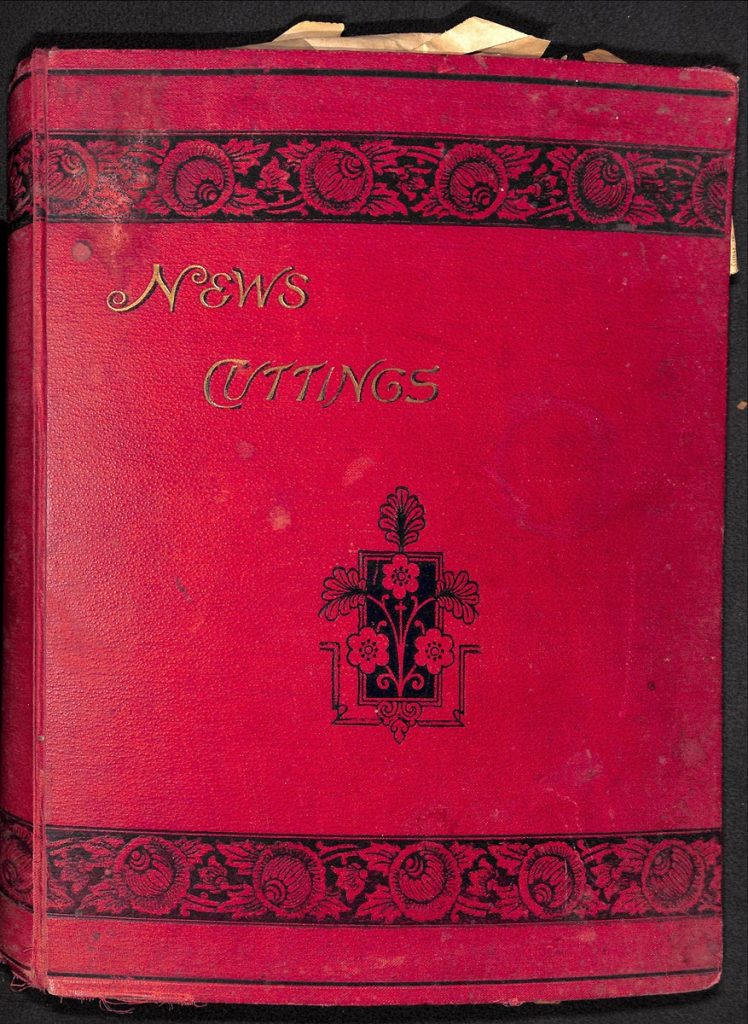
The cover of one of Stead’s scrapbooks (MS-1205/04). The collection contains three more scrapbooks, a folder of victory telegrams and a publication.
Scrapbooks can be a rich source of information. Upon opening the cover of a scrapbook a researcher can immediately sense the importance the material held to the compiler. They provide a fantastic record of people’s memories and experiences and as a result offer insight into society at the particular time the material was collated. Stead’s scrapbooks are no exception: they cover his whole career and in the process illustrate rugby’s launch into New Zealand popular culture.
Stead was born in Invercargill on 21 September 1877. He started his rugby career in 1896 when he played for the Star Club and was subsequently chosen for the Southland and South Island representative teams. He went on to tour Australia with the New Zealand side, and in 1903 and 1904 captained the team against the visiting British squad.[1] In 1905 Stead was named vice-captain of the Originals on the first official tour of the United Kingdom by a fully representative New Zealand team. This tour saw the side famously win a staggering 31 out of 32 games, scoring 830 points against only 39.[2]
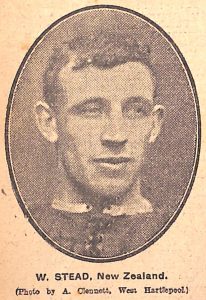
A photograph of Stead in an unreferenced newspaper article covering the Originals win over Northumberland. This dates the photograph to c. late November, early December 1905. (MS-1205/03)
The first team photograph of the Originals was taken by a local photographer in Newton Abbot, Devon, before New Zealand’s opening match on tour. The team’s departure in 1905 had been met with little excitement from the New Zealand public but once the Originals began to defeat a personification of the colonial power at their own game and on their own turf, this started to change. Within hours of the photograph being printed, it went on sale as a postcard and subsequently become incredibly popular with the public. Thousands of copies were distributed throughout the country and many were sent with messages back to family and friends in New Zealand.[3]
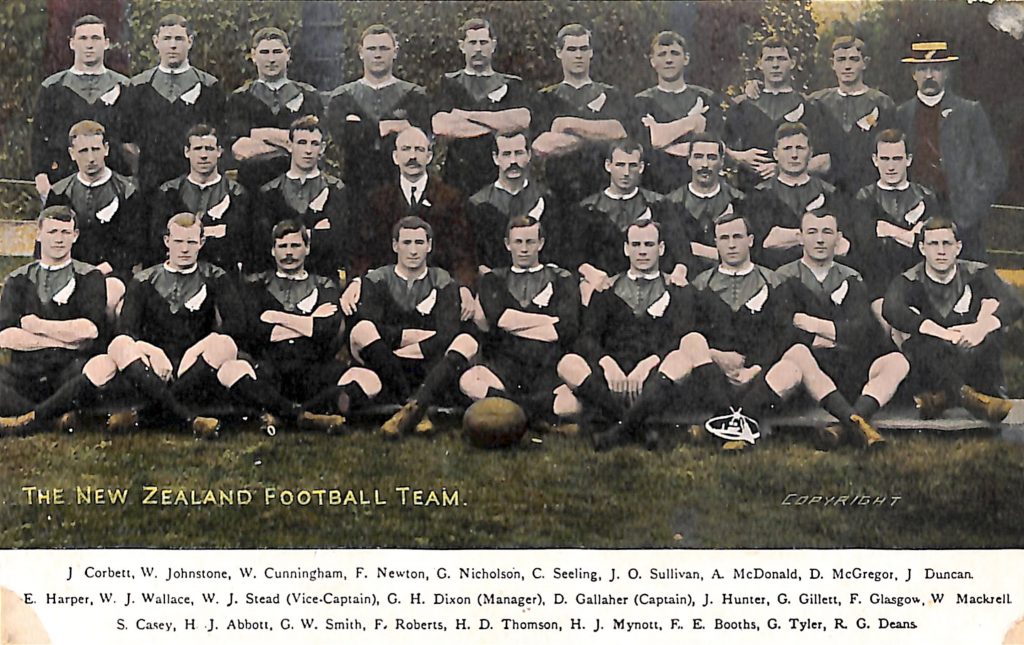
The photograph features in postcard form in one of Stead’s scrapbooks. (MS-1205/04)
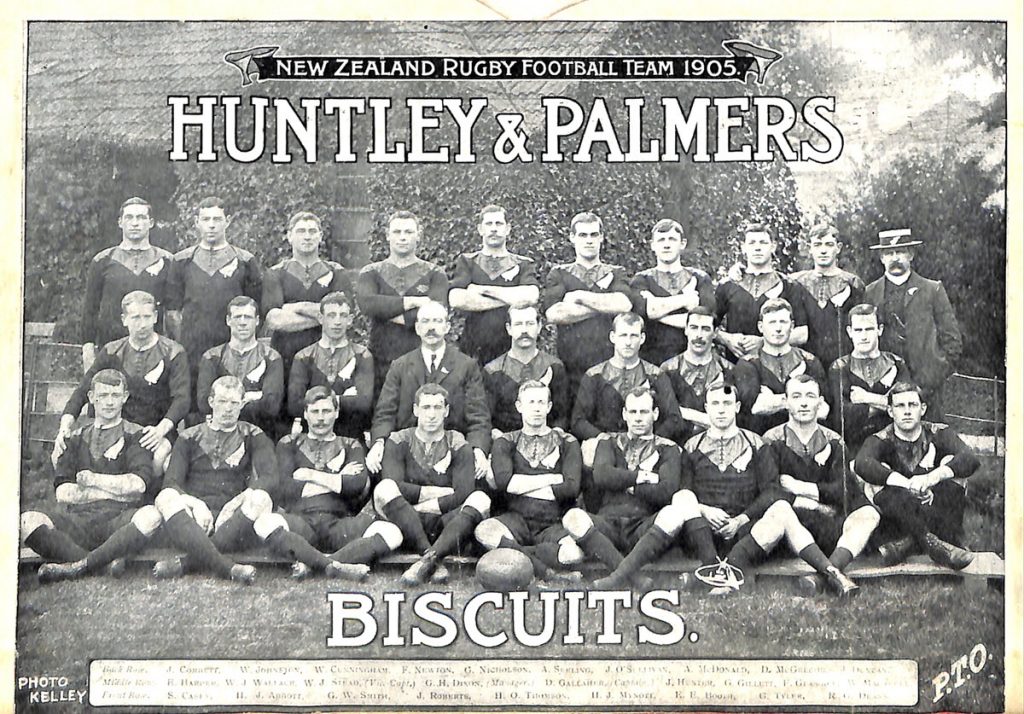
Businesses also took advantage of the team’s success and used the photograph for promotional purposes as seen in this Huntly & Palmers Biscuits advertisement. (MS-1205/03)
The tour was supposed to have reinforced strong bonds within the British Empire but instead New Zealand was emerging with its own national identity as the home-land of unconquerable heroes.[4] The nation’s character was now defined by the ability to perform amazingly well on foreign soil after travelling for weeks at sea. This showed the Originals were capable of adapting, handling huge pressure and working together as a team.[5] These were relatable qualities to the general population of New Zealand, as displayed a few generations earlier when the first settlers were faced with their own challenges in an unfamiliar land.
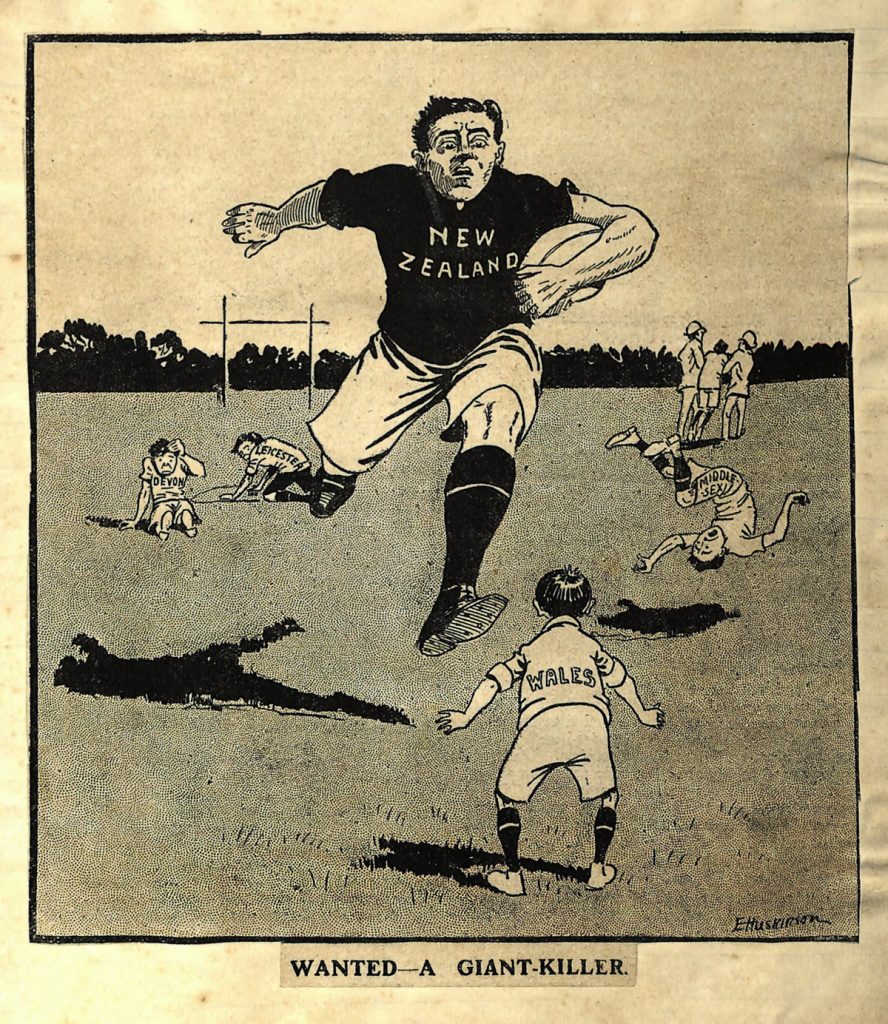
This cartoon is titled ‘Wanted – a giant killer’ and its illustration of various representatives from the British Isles as feeble competitors compared to the New Zealand giant perfectly depicts how the New Zealand spirit was being personified. It was originally published in Free Lance, Volume XI, Issue 283, 2 December 1905. (MS-1205/03)
The government back home took advantage of the Originals success by placing advertisements in British newspapers encouraging new migrants to New Zealand by calling upon the newly appointed characteristics of this impressive population. On 1 January 1906 the Christchurch Press reported ‘Apart from the effect of the campaign upon the game, both at Home and in the colony, it has been one of the greatest advertisements the colony has ever had, and has probably done more to “bloom” New Zealand with the British public than did the dispatch of our Contingents to South Africa, or all Mr. Seddon’s quaint efforts to attract attention to these islands.’[6]
The only game the side lost was against Wales (0-3) – which happened to be the only game of the tour Stead did not play. However, Stead was not only a talented player, he was also very perceptive and had the ability to turn what he was observing into the written word. Before the team had left New Zealand, the Southland Times asked Stead to write a diary of the tour. His accounts, titled With the New Zealand Footballers, were predominately about the team’s journey at sea and the experiences of a New Zealander visiting Britain for the first time, as opposed to rugby. He outlined his surroundings and brought the whole experience to life for the average New Zealander.
In his last diary submission, printed on 14 March 1906, the reader can sense the emotion, pride and gratitude of Stead and his team mates. ‘In conclusion, as a team we feel that from now onward we cease to exist; friendships have sprung up in our travels that will be lifelong, and the many incidents and good-natured banter which have been part of our life will be constantly in the sweet thoughts of memory, and I think I may say that the 1905 team, the account of whose travels it has been a pleasure to me to record to you in these columns, has been a credit to New Zealand from every point of view.’[7]
Stead also co-authored one of the classics of rugby book publishing, The complete rugby footballer on the New Zealand system, with Captain Dave Gallaher. It was completed within a very short timeframe but over 322 pages Stead and Gallaher managed to trace the development of rugby in New Zealand. Through text, photographs and diagrams they covered captaincy, coaching, tactics, equipment, training and how they prepared for the tour.
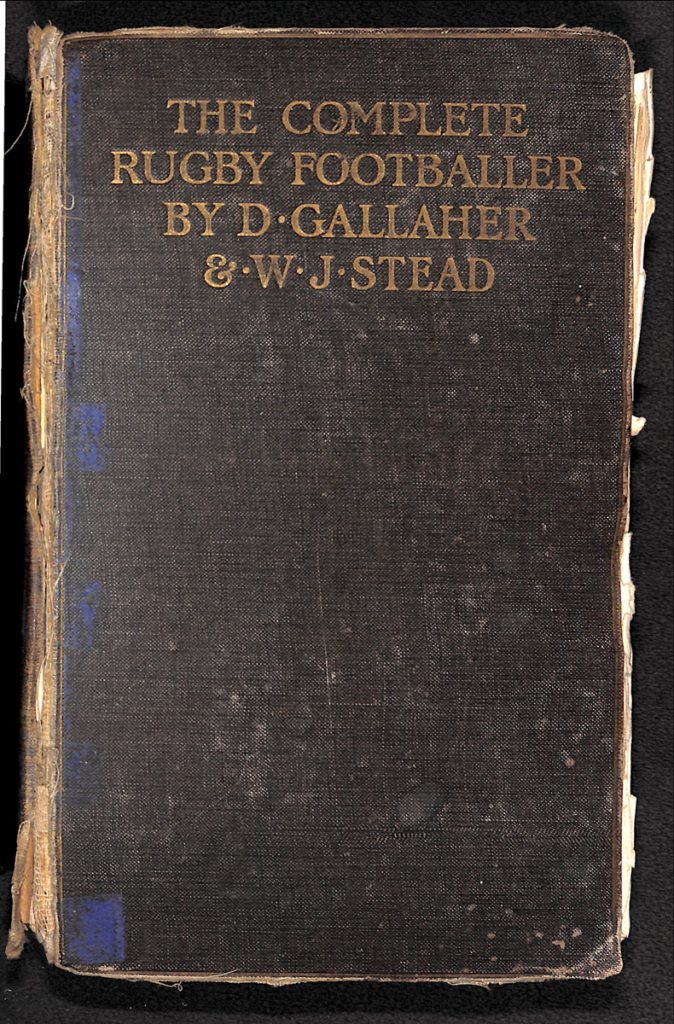
In the Stead papers we hold Stead’s very own, well used, copy of The complete rugby footballer. (MS-1205/06)
Here at Hocken we hold two copies of The complete rugby footballer on the New Zealand system – one in the published collection and one with Stead’s papers. We also hold two compilations of his columns from the Southland Times – With the New Zealand footballers: [excerpts from the columns of the Southland Times concerning the New Zealand Rugby Tour of Great Britain, 1905-1906] and Billy’s trip home: the remarkable diary of an All Black on tour.
Due to the success of this tour, the fascination with New Zealand’s triumph and the embodiment of the New Zealand spirit in players such as Stead, rugby became a national passion and obsession throughout New Zealand. For the first time, rugby was entering the realm of literature, widespread newspaper coverage and pictorial representation. As a result, the Originals were projected into popular culture and to this day, New Zealander’s still draw upon this legendary tour as the beginning of our nation’s reputation as unbeatable in the rugby arena.
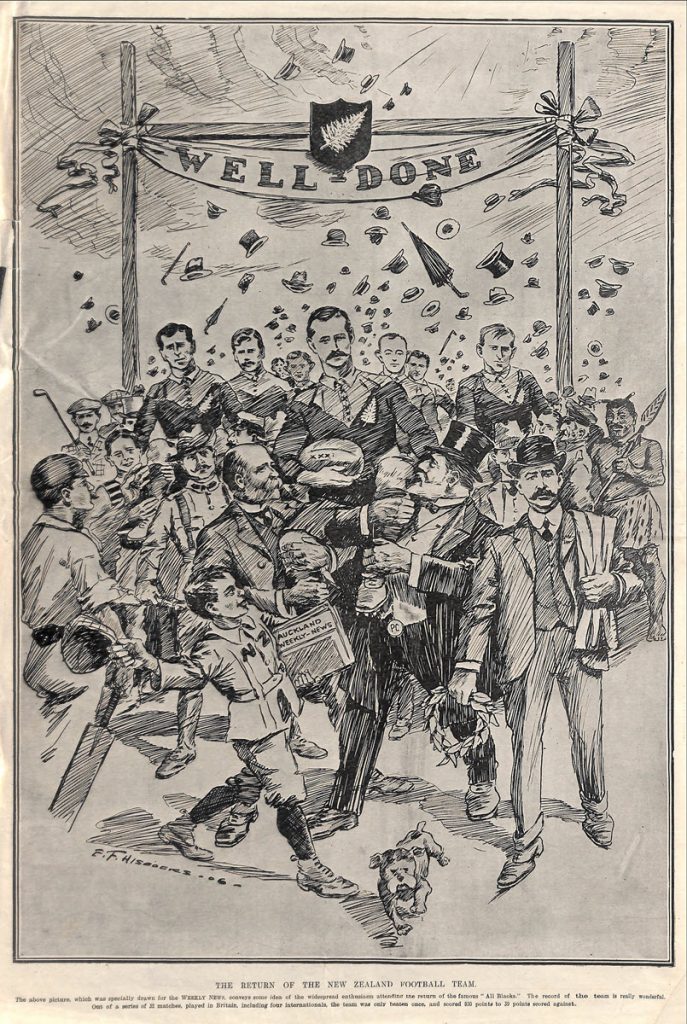
This cartoon was originally printed in The Auckland Weekly News, 8 March, 1906 and features in one of Stead’s scrapbooks (MS-1205/02). Its caption reads ‘The above picture, which was specially drawn for The Weekly News, conveys some idea of the widespread enthusiasm attending the return of the famous “All Blacks”. The record of the team is really wonderful. Out of a series of 32 matches, played in Britain, including four internationals, the team was only beaten once and scored 830 points to 39 points scored against.’ The use of the silver fern motif and the team name “All Blacks” were first adopted during this famous tour.
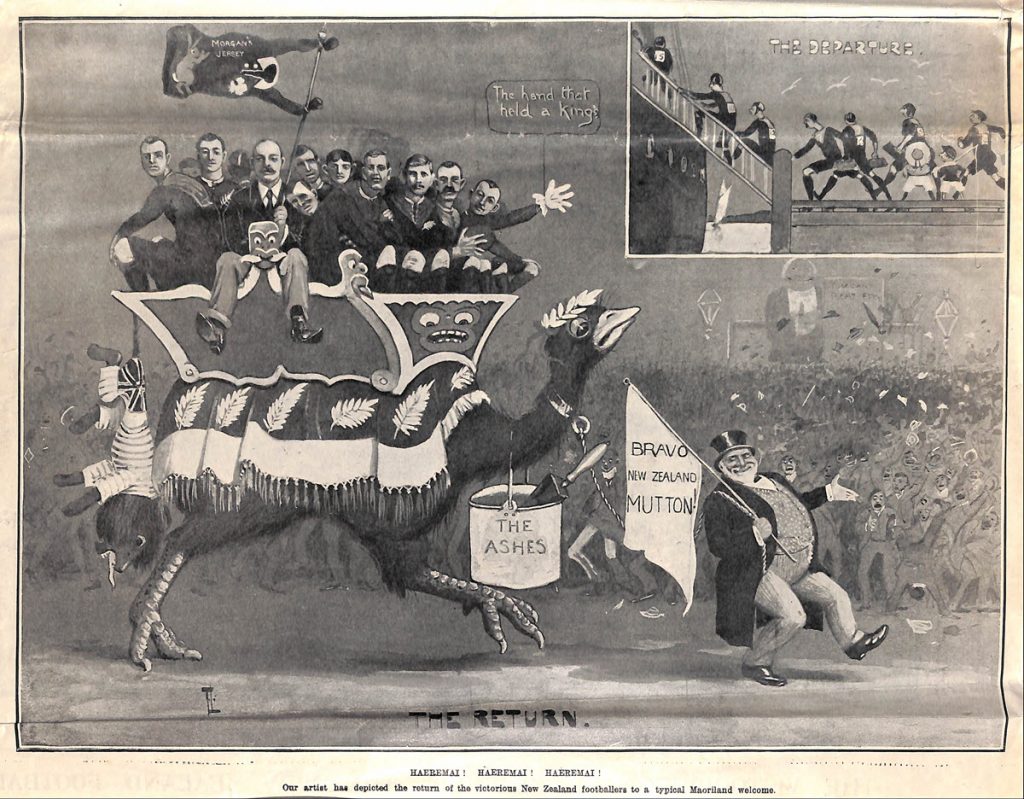
This cartoon was originally printed in The Auckland Weekly News, 8 March, 1906 and features in one of Stead’s scrapbooks (MS-1205/02). Its caption reads ‘Haeremai! Haeremai! Haeremai! Our artist had depicted the return of the victorious New Zealand footballers to a typical Maoriland welcome.’ The victorious team are shown riding astride a moa while an English lion bearing the union jack is hung from the rear. Their quiet, nondescript departure is compared with a joyous crowd of celebrators on their return.
If you are interested in finding out more about this legendary tour the Hocken publications collection holds a large amount of material pertaining to it and our ephemera collection contains many programmes for All Black matches that continue to reference the Originals’ success years later. We are also home to an additional set of scrapbooks (SER-09625) complied by another All Black, Jack McNab, covering the period 1948-1966 which continue this illustration of All Black supremacy through newspaper clippings and cartoons.
The ongoing tradition of international rugby tours can be celebrated this weekend when the All Blacks take on England. At a time when travel is swift and sporting results are communicated around the world instantly, perhaps we can try to imagine how different the experience was for the Originals and for fans back home in 1905.
[1] Thomson, Jane. Southern People: A Dictionary of Otago Southland Biography. Dunedin, N.Z: Longacre Press in association with the Dunedin City Council, 1998.
[2] Stead, W. J. Billy’s trip home: the remarkable diary of an All Black on tour. Dunedin N.Z.: New Zealand Sports Hall of Fame, 2005.
[3] Howitt, Bob and Dianne Haworth. 1905 Originals: the remarkable story of the team that went away as the Colonials and came back as the All Blacks. Auckland, N.Z.: HarperSports, 2005.
[4] Ryan, Greg. 1905, legend and legacy. Christchurch, N.Z.: Canterbury History Foundation, 2005.
[5] Tobin, Christopher. The original All Blacks: 1905-06. Auckland, N.Z.: Hodder Moa Beckett, 2005.
[6] https://paperspast.natlib.govt.nz/newspapers/CHP19060101.2.21?end_date=01-01-1906&phrase=0&query=football&start_date=01-01-1906&title=CHP&type=ARTICLE
[7] https://paperspast.natlib.govt.nz/newspapers/ST19060314.2.43?end_date=14-03-1906&phrase=0&query=stead&start_date=14-03-1906&title=ST&type=ARTICLE
